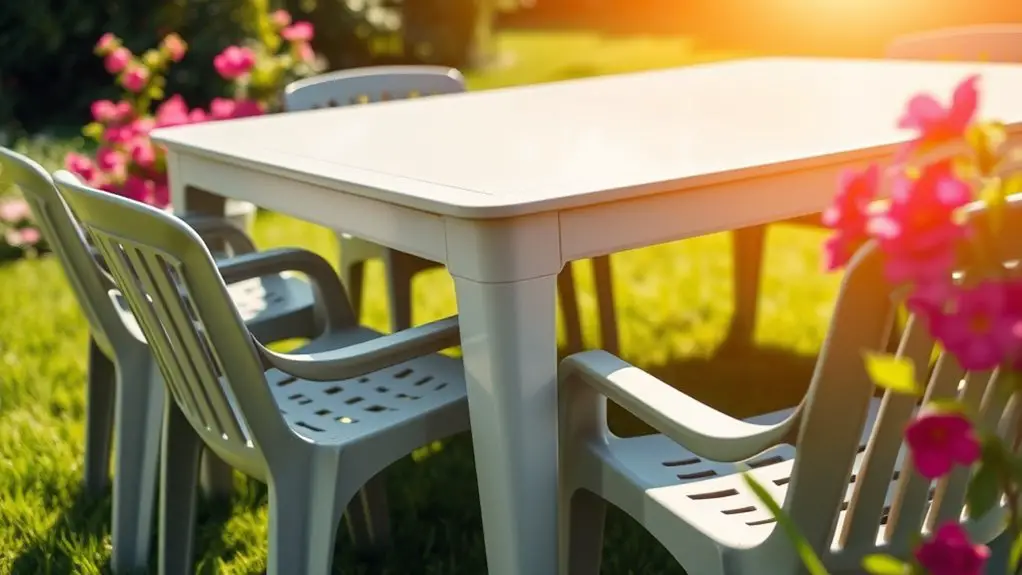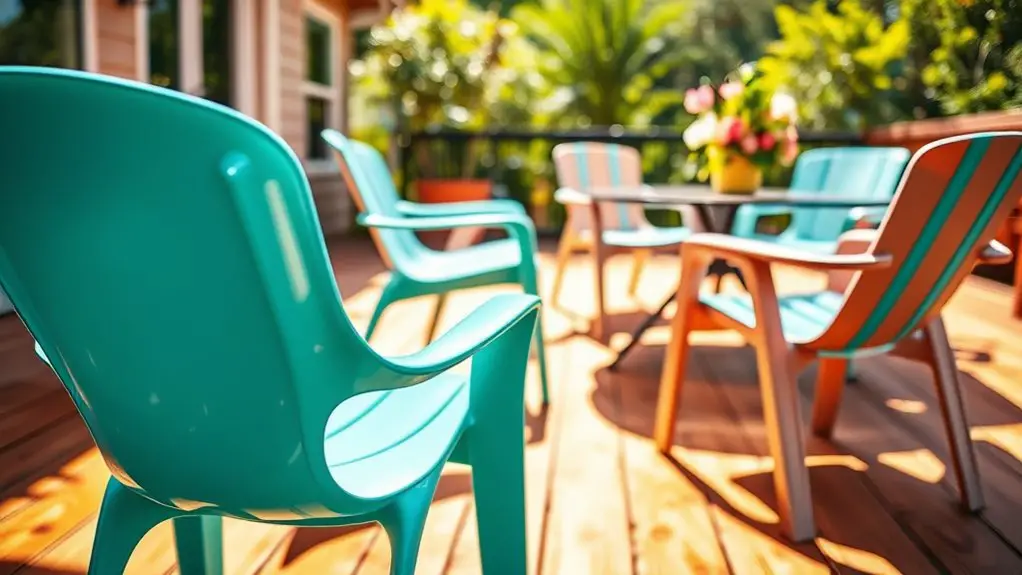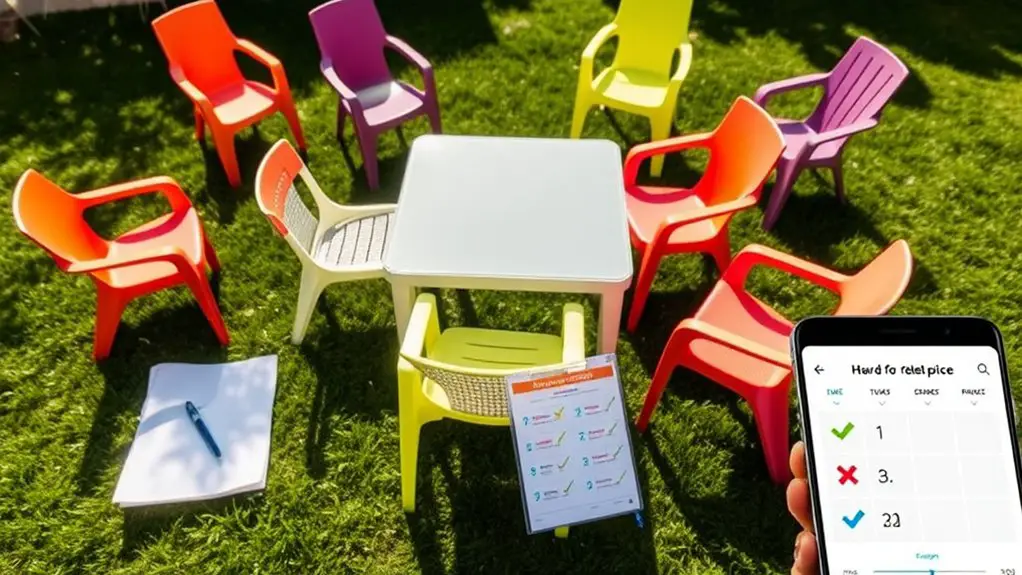When buying plastic furniture, you'll want to ask several important questions. What's the material quality? Look for high-density polyethylene or polypropylene for durability. How will climate affect your furniture? Consider its resilience to weather and UV exposure. What's the expected lifespan? Quality pieces can last for decades. Think about the cost versus value; affordable options can still offer longevity. Style matters too—choose colors and designs that fit your taste. Lastly, find out what maintenance is needed; simple cleaning often suffices. These considerations will guide you through a wise purchase, and there's more to explore on this topic.
Key Takeaways
- What materials are used in the furniture, and do they offer the required durability and weather resistance for your needs?
- How does the furniture handle UV exposure, and what features are in place to prevent fading or structural failure?
- What are the recommended maintenance and cleaning requirements to ensure the furniture remains in good condition over time?
- Are there seasonal storage recommendations to protect the furniture from extreme weather conditions and prolong its lifespan?
- What is the warranty period, and how does the cost of the furniture compare to its expected longevity and maintenance expenses?
What Is the Material Quality?
When you're considering plastic furniture, its material quality plays a crucial role in your decision. High-density polyethylene (HDPE) and polypropylene are the top choices for their impressive strength and resilience. These materials can handle impacts without cracking or splintering, making them ideal for everyday use and high-traffic areas.
You'll appreciate that they withstand frequent folding and unfolding without significant wear, maintaining their structural integrity over time. Additionally, manufacturers focus on quality materials to ensure long-lasting performance. They are also an environmentally friendly option as many plastic furniture pieces are made from recycled materials, reducing resource demand and supporting a circular economy.
Another major advantage is their weather resistance. HDPE and polypropylene don't just endure sun and rain; they also resist extreme temperatures. With UV stabilizers and pigments, you won't have to worry about fading, warping, or discoloration.
Plus, they won't rust or degrade from moisture, ensuring your furniture remains both visually appealing and structurally sound.
Durability is another key factor. Quality plastic furniture can last over ten years in home settings, reducing the need for frequent replacements.
It's resistant to stains, scratches, and dents, which further enhances its longevity. By understanding the material quality, you can confidently choose plastic furniture that meets your needs.
How Will Climate Affect Usage?
When considering plastic furniture, think about how temperature and UV exposure can impact its longevity. High heat can affect some plastics, while UV rays might fade colors over time. Additionally, seasonal storage can help extend the life of your furniture, so it's worth planning for those shifts in climate. To further enhance durability, many recycled plastic products are resistant to weather and designed to withstand the elements.
Temperature Impact on Longevity
Extreme temperatures can significantly impact the longevity of your plastic furniture, making it crucial to consider your local climate before purchasing. High temperatures can cause your furniture to heat up, especially if it's a darker color. This prolonged exposure may lead to warping or fading over time, compromising the structural integrity of the plastic. If you live in a hotter region, opting for UV-resistant plastics can help mitigate some of these effects.
On the flip side, cold temperatures can also pose risks. When the mercury drops, plastic furniture can become brittle, increasing the likelihood of cracking or breaking upon impact. For instance, polyethylene can turn brittle at temperatures below 20°F (-6°C), while polypropylene and PVC may crack when it's below freezing. To prevent damage during winter, it's best to store your furniture indoors.
Additionally, moisture and humidity can affect plastic furniture. While most are designed to withstand rain, water pooling in cracks can lead to mold or mildew. Regular cleaning and proper drainage are essential for maintenance. By considering these temperature impacts, you can make an informed decision that ensures the longevity of your plastic furniture. Investing in high-quality plastic furniture enhances its durability and lifespan, providing greater value over time.
UV Exposure Considerations
UV exposure is a significant factor to consider before buying plastic furniture, especially if you live in a sunny climate. Prolonged exposure to sunlight can lead to various issues that affect both the appearance and durability of your furniture.
Here are three key points to keep in mind:
- Degradation of Materials: UV rays break down polymer bonds, leading to embrittlement and loss of mechanical integrity. Over time, this can result in structural failures. This degradation is often exacerbated by the absence of stabilization additive packages, which can mitigate the effects of UV damage.
- Visual Changes: You might notice discoloration, such as yellowing or fading, alongside surface damage like chalking and small cracks. These changes not only detract from the furniture's attractiveness but also indicate a decline in quality.
- Reduced Performance: Constant exposure can weaken tensile strength and impact resistance, especially in materials like polyethylene and polypropylene. Eventually, you'll find that the furniture doesn't hold up as well as it once did.
Understanding these UV exposure considerations will help you make an informed decision, ensuring your plastic furniture remains functional and visually appealing for years to come.
Seasonal Storage Recommendations
Preparing your plastic furniture for seasonal changes is essential to maintaining its longevity and appearance. Start by cleaning your furniture with mild detergent and water in the spring to remove any winter dust. Allow it to dry completely before applying a UV-resistant spray to protect against sun damage. Regular cleaning during this time is also important to ensure that your furniture remains in optimal condition.
Investing in climate-resistant covers is crucial, as they shield your furniture from rain and pollen while ensuring airflow to prevent mold.
During summer, opt for UV-resistant furniture and use covers with stable tie-downs to keep everything secure against breezes. Regular cleaning and protective coatings will help maintain its appearance.
As fall approaches, clean your furniture thoroughly and apply a wax coating for added moisture protection. Store it in a covered, well-ventilated space, using stackable or foldable options to maximize storage.
In winter, ensure your furniture is dry before storing it in a protected area. Avoid placing it near heating sources or areas prone to moisture.
Using protective covers or storage bags can shield your furniture from snow and ice, while humidifiers or dehumidifiers help maintain optimal indoor humidity levels.
What Is the Expected Durability?

When considering plastic furniture, you need to think about the lifespan of the materials used and how much maintenance they'll require.
High-density polyethylene and polypropylene are designed to last, but regular upkeep can extend their life even further.
Knowing the expected durability will help you make a smart investment for your space.
Lifespan of Materials
Durability is a key factor to consider when buying plastic furniture. The materials used, such as high-density polyethylene (HDPE) and polypropylene, offer exceptional strength and resilience. These plastics resist impacts and won't crack or splinter, making them suitable for high-traffic areas.
With proper care, you can expect longevity from your plastic furniture. Here's what you can look forward to:
- Residential Use: Your furniture can last over ten years indoors, providing long-term value.
- Commercial Use: Expect a lifespan of more than five years, ideal for business settings.
- Recycled Options: Some recycled plastic furniture can endure for up to 50 years or more.
Additionally, plastic furniture withstands various weather conditions without fading, warping, or rusting. Its UV-resistant properties help maintain its color and integrity even under the sun.
You'll find that it's also resistant to stains, scratches, and dents, allowing it to retain its original condition with minimal wear and tear.
All these factors make plastic furniture a cost-effective and sustainable choice for both indoor and outdoor settings.
Maintenance Requirements
Maintaining your plastic furniture is essential to ensure it lasts as long as possible. Start by regularly cleaning the surfaces with a soft-bristled brush or vacuum to remove debris like leaves or pet hair.
For deeper cleaning, use a mild soap solution with warm water, avoiding harsh scrubs and abrasive cleaners that could damage the finish. Rinse thoroughly to eliminate soap residue and allow the furniture to air dry completely before using it again.
To protect your furniture from environmental factors, keep it covered during harsh weather conditions to prevent corrosion. Regularly check for wear or rust and address these issues promptly.
Opt for UV-resistant materials to guard against sun damage and discoloration. Additionally, store your furniture in a protected area during extreme weather to prolong its lifespan.
Plastic furniture is generally resistant to stains, scratches, and dents, which minimizes your maintenance efforts. Regular cleaning prevents dirt buildup and maintains its appearance.
Avoid using harsh chemicals, and always test any cleaning solution on a small area first. Following these guidelines will help ensure your plastic furniture remains durable and visually appealing for years to come.
What Is the Cost vs. Value?
Understanding the cost versus value of plastic furniture can help you make an informed decision for your outdoor space. When comparing costs, you'll find that recycled plastic outdoor furniture is generally more affordable than traditional options.
Plus, shipping costs can be lower due to the lighter weight of plastic.
Here are three key points to consider regarding value:
- Longevity: Well-maintained recycled plastic furniture can last decades, with warranties ranging from 5 to 10 years for HDPE furniture, depending on usage.
- Low Maintenance Costs: You won't have to spend much on upkeep. A simple wash with soapy water is all it takes, and there's no need for special treatments.
- Durability: Plastic furniture is resistant to weather, fading, and wear, making it a cost-effective choice in the long run.
How Important Is Style?

Style plays a crucial role when selecting plastic furniture for your outdoor space. The versatility in colors and designs allows you to choose pieces that truly reflect your personal taste.
Whether you lean towards contemporary looks with clean lines or prefer classic designs, you'll find options that fit your aesthetic perfectly.
Plastic furniture can even mimic the appearance of wood, offering various textures and finishes, enhancing your outdoor environment with both earthy tones and bold shades.
The ability to customize not only extends to color but also includes different configurations and sizes, making it easy to match your existing decor.
With options that feature organic curves or geometric cutouts, you can create an inviting atmosphere that feels both open and stylish.
This flexibility allows you to rearrange and repurpose your furniture as needed, ensuring it complements your space seamlessly.
Ultimately, style isn't just about looks; it's about creating a cohesive environment that resonates with your lifestyle.
What Are the Maintenance Requirements?
When it comes to plastic furniture, proper maintenance is essential for keeping it looking great and lasting longer. By following some simple cleaning methods and avoiding harmful substances, you can ensure your furniture stays in top condition.
Here are three key maintenance requirements to keep in mind:
- Regular Cleaning: Use a microfiber cloth to dust regularly. For deeper cleaning, mix lukewarm water with mild soap. Avoid abrasive cleaners that can scratch the surface, and steer clear of bleach to prevent fading.
- Special Care for Outdoor Use: If your furniture spends time outdoors, clean it with a mild soapy solution and rinse thoroughly with a hose. Make sure it's designed for outdoor conditions to withstand the elements.
- Drying: After cleaning, pat your furniture dry with a soft cloth to prevent water spots. If you can, let it air dry in the sun, which helps maintain its condition.
Frequently Asked Questions
Are There Specific Brands Known for High-Quality Plastic Furniture?
Yes, you'll find several brands known for high-quality plastic furniture. Notable names include Architects Furniture, Kinetic Products Corp., and Hawthorn Furniture Co. They offer durable, stylish options for various needs and settings.
How Do I Properly Store Plastic Furniture During Winter?
To properly store your plastic furniture during winter, clean it thoroughly, inspect for damage, disassemble if possible, and store in a dry, climate-controlled space. Cover with breathable fabric and elevate to prevent moisture absorption.
Can Plastic Furniture Be Recycled at the End of Its Life?
Yes, you can recycle plastic furniture at the end of its life. Make sure to check local recycling guidelines, as different types of plastics may have specific collection methods or facilities for proper recycling.
Are There Weight Limits for Plastic Furniture Pieces?
Yes, plastic furniture has weight limits. While some chairs claim high capacities, actual limits often range from 200 to 350 pounds. Always check the manufacturer's specifications to ensure safe usage for your needs.
How Can I Prevent My Plastic Furniture From Fading?
To prevent your plastic furniture from fading, use UV-resistant materials, apply protective coatings regularly, and cover the furniture when not in use. Consider providing shade and store it during intense sunlight for added protection.

